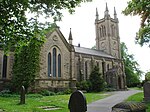St Margaret's Church, Halliwell
20th-century Church of England church buildingsAnglican Diocese of ManchesterAustin and Paley buildingsBuildings and structures in BoltonChurch of England church buildings in Greater Manchester ... and 2 more
Gothic Revival architecture in Greater ManchesterGothic Revival church buildings in England

St Margaret's Church is in Lonsdale Road, Halliwell, Bolton, Greater Manchester, England. It is an active Anglican parish church in the deanery of Bolton, the archdeaconry of Bolton, and the diocese of Manchester. Its benefice is united with that of Christ Church, Heaton.
Excerpt from the Wikipedia article St Margaret's Church, Halliwell (License: CC BY-SA 3.0, Authors, Images).St Margaret's Church, Halliwell
St Margaret's Close,
Geographical coordinates (GPS) Address External links Nearby Places Show on map
Geographical coordinates (GPS)
| Latitude | Longitude |
|---|---|
| N 53.5844 ° | E -2.4569 ° |
Address
The Parish Church of St. Margaret
St Margaret's Close 43
BL1 4QH , Heaton
England, United Kingdom
Open on Google Maps




